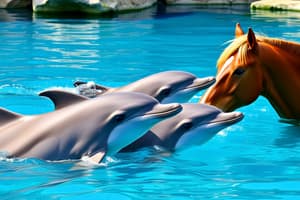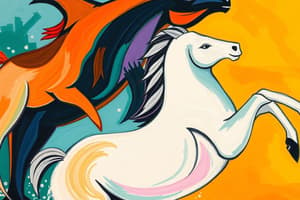Podcast
Questions and Answers
What are the primary threats to blue whales?
What are the primary threats to blue whales?
- Hunting and habitat destruction
- Climate change and poaching
- Overpopulation of krill
- Boats and pollution (correct)
At what age does a horse transition from a foal to a yearling?
At what age does a horse transition from a foal to a yearling?
- 6 months
- 1 year (correct)
- 2 years
- 3 years
What do horses primarily consume along with their food?
What do horses primarily consume along with their food?
- Fruits and vegetables
- Lots of water (correct)
- Insects and plants
- Large amounts of grass
What is the term for accidentally catching non-target species while fishing?
What is the term for accidentally catching non-target species while fishing?
Which type of diet is characteristic of a howler monkey?
Which type of diet is characteristic of a howler monkey?
How many stages are there in a simple life cycle?
How many stages are there in a simple life cycle?
Which of the following describes the beginning of a crocodile's life cycle?
Which of the following describes the beginning of a crocodile's life cycle?
What is the primary diet of thorn bugs?
What is the primary diet of thorn bugs?
How do jellyfish primarily capture their prey?
How do jellyfish primarily capture their prey?
What is the typical lifespan of a horse?
What is the typical lifespan of a horse?
What type of environment do crocodiles prefer for living?
What type of environment do crocodiles prefer for living?
Which species is known for having a mantle that helps camouflage cubs?
Which species is known for having a mantle that helps camouflage cubs?
Which part of a plant absorbs water and nutrients?
Which part of a plant absorbs water and nutrients?
What diet do horses generally require to stay healthy?
What diet do horses generally require to stay healthy?
What is a common characteristic of cheetahs that allows them to run fast?
What is a common characteristic of cheetahs that allows them to run fast?
What distinguishes angiosperms from gymnosperms?
What distinguishes angiosperms from gymnosperms?
What is the initial stage of a monkey's life cycle called?
What is the initial stage of a monkey's life cycle called?
What is the main diet of hippos?
What is the main diet of hippos?
What is a defining characteristic of insectivorous lizards?
What is a defining characteristic of insectivorous lizards?
What effect do hippos have on their environment due to their feeding patterns?
What effect do hippos have on their environment due to their feeding patterns?
Which type of dolphin lives closer to the beaches?
Which type of dolphin lives closer to the beaches?
What type of habitat do wild horses prefer?
What type of habitat do wild horses prefer?
What is the primary reason for the cheetah’s endangered status?
What is the primary reason for the cheetah’s endangered status?
Which animals primarily inhabit the African savanna?
Which animals primarily inhabit the African savanna?
What is one of the major threats to lion populations?
What is one of the major threats to lion populations?
What significant action led to the decline of the blue whale population in the past?
What significant action led to the decline of the blue whale population in the past?
What type of food do horses primarily consume?
What type of food do horses primarily consume?
Which environmental threat is commonly faced by savannas?
Which environmental threat is commonly faced by savannas?
What is one of the main factors contributing to the decline in the lion population?
What is one of the main factors contributing to the decline in the lion population?
What factor is essential for dolphins when traveling in pods?
What factor is essential for dolphins when traveling in pods?
Flashcards are hidden until you start studying
Study Notes
Marine Mammals
- Dolphins inhabit moderate to warm ocean waters globally, with coastal varieties near beaches and offshore species residing in deeper waters.
- Dolphins travel in pods for social behavior, food hunting, and predator evasion.
Equine Habitats
- Domesticated horses can adapt to various settings; wild horses prefer open plains and prairies for safety and grazing.
- They require shelter from elements, grassy areas for feeding, and ample fresh water.
Cheetah Facts
- Cheetahs hold the title for the fastest land mammal, able to reach speeds of 60 mph in just three seconds.
- Habitat loss, prey scarcity, and threats from humans contribute to their endangered status.
African Savanna
- Savannas are vast tropical grasslands that serve as vital habitats for both herbivores (e.g., giraffes, zebras) and carnivores (e.g., lions, hyenas).
- Habitat destruction and hunting threaten this ecosystem and its wildlife.
Lion Endangerment
- Multiple lion species face extinction risks due to habitat destruction and diminishing prey, exacerbated by human population growth.
- Conservationists are actively working on initiatives to boost lion populations.
Blue Whale Conservation
- The blue whale, once heavily hunted, is now endangered due to historical whaling and current threats like pollution and climate change.
- They face risks from noise pollution, boat collisions, and diminishing krill populations.
Great White Shark
- Great white sharks are endangered due to human factors such as pollution and illegal fishing practices.
- Protective measures and bans on shark fin soup have sparked recovery efforts.
Snake Adaptability
- Snakes inhabit diverse environments and are found globally, particularly in tropical climates.
- They regulate their body temperature by moving to different areas within their habitats.
Horse Life Cycle
- Horses undergo a life cycle encompassing stages: foal at birth, yearling at one year, colt/filly at two years, and adulthood at four.
- Lifespan averages around 25 years.
Lion Cubs
- Lion cubs experience rapid development, becoming independent and sexually mature within six years.
- They learn to hunt and socialize within their pride.
Tiger Development
- Tiger cubs are blind at birth and depend on maternal care for survival.
- Cubs transition to young adults and develop hunting skills between 17 months and two years.
Crocodile Life Cycle
- Crocodile life cycle stages include pre-birth (nesting), juvenile, and adulthood.
- Nesting involves creating shelters for egg development.
Monkey Life Cycle
- Monkeys experience life stages from gestation to adulthood, typically faster than humans, lasting 10 to 50 years depending on species.
Chicken Development
- Newly hatched chicks are called pullets until they can lay eggs and generally have a lifespan of 2 to 25 years.
- Hens contribute to embryo development by incubating eggs.
Cheetah Cubs
- Cheetah cubs are vulnerable at birth, with a distinctive mantle for camouflage.
- They engage in play to practice hunting skills.
Cheetah Speed
- Adaptations allow cheetahs to sprint at high speeds for short bursts but tire quickly afterward.
White Bengal Tigers
- White Bengal tigers, often termed “snow tigers,” lack the pigment pheomelanin, resulting in their unique coloration.
- They are primarily found in captivity due to their rarity.
Horse Nutrition
- Horses require a balanced diet comprised of grasses, hay, grains, fruits, and vegetables for healthy energy levels.
- Hydration is crucial, as they drink considerable amounts of water.
Crab Diversity
- There are over 4,000 crab species, with diverse diets as scavengers, carnivores, or omnivores based on habitat.
Hippopotamus Feeding
- Hippopotamuses are herbivorous, grazing on grasses for several hours at night and significantly shaping their environment.
Lizard Varieties
- Lizards exhibit varied diets based on species, including herbivores, carnivores, and insectivores.
Monkey Diets
- Of the over 260 monkey species, most are omnivorous; specialized diets exist, such as the howler monkey (foliovore) and the owl monkey (frugivore).
Jellyfish Characteristics
- Jellyfish are ancient, carnivorous creatures devoid of backbones, with a unique structure for capturing prey.
- Group gatherings of jellyfish are known as blooms.
Thorn Bug Attributes
- Thorn bugs utilize thorn-like horns for camouflage and primarily consume plant sap.
- They are sometimes seen as pests due to potential damage to fruit trees.
Crocodile Habitat Preferences
- Crocodiles thrive in tropical habitats with brackish water and safe nesting sites, but habitat loss threatens some species.
Tree Anatomy
- A tree consists of three main parts: the crown, trunk, and roots, with the trunk having five layers: bark, cambium, heartwood, phloem, and xylem.
Plant Classification
- Plants are classified as angiosperms (flowering) or gymnosperms (non-flowering), with various reproduction methods using seeds or spores.
Importance of Plants
- Plants play crucial roles by providing oxygen and food; each part contributes significantly to sustenance and survival on Earth.
Studying That Suits You
Use AI to generate personalized quizzes and flashcards to suit your learning preferences.




